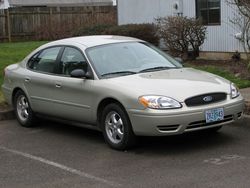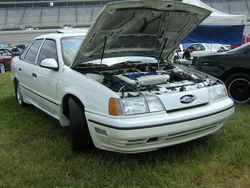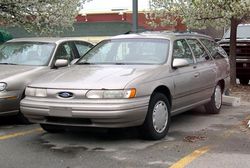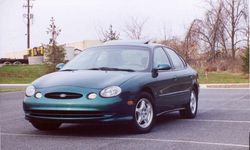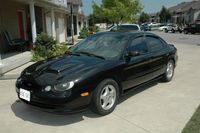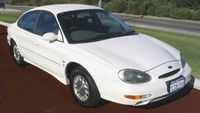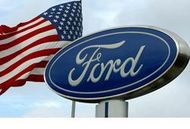.
Ford Taurus
The Ford Taurus (from Latin "bull") is a mid-size car sold by the Ford Motor Company in North America. Introduced in December 1985 as a 1986 model, Ford has sold nearly 7 million Tauruses during its 20 years of production. The Taurus also had a Mercury sibling called the Sable. Most Tauruses were built in either Chicago, Illinois (until April 23, 2004, at which time the plant was retooled to build the Five Hundred), or in Atlanta, Georgia.
This model was a bold new step in American automobile design. For the first time in many decades, an American manufacturer was building a world class car, inspired by successful European designs, which were making huge inroads in the American premium sedan market. Ford took a huge gamble in basing its bread and butter car on the 1984 Audi 5000, which in turn was patterned on the radical 1975 Citroën CX.
The car was given a major facelift in 1992 and a major redesign in 1996, followed by two design updates in 2000 and 2004. Between 1992 and 1996, the Taurus was the best-selling car in the United States, losing the title in 1997. During that period, the Ford F-150 remained the country's best-selling vehicle, leading sales along with several other vehicles not classified as "cars".
First generation (1986–1991)
The 1986 Ford Taurus was a very important and successful mid-size sedan that introduced a radical new design philosophy to the United States. Replacing the Ford LTD, the front wheel drive Taurus introduced a much rounder and more organic design. Often described as "jelly bean" shaped, the design proved successful and helped to launch Ford into a new era of prosperity. The Taurus ultimately led to a US automobile design revolution that saw the end of the "boxy" cars of the 1970s and 1980s.
The Taurus and Sable siblings used flush aerodynamic halogen headlights. Ford was the first to produce and sell vehicles with such headlights in the U.S. when it introduced the Lincoln Mark VII in 1984. To do so, Ford had to lobby the NHTSA to have them approved. The Taurus/Sable were the first domestically produced, mainstream sedans to use the new lights.
For 1986, the engines were a 90 hp (67 kW) 2.5 L 4-cylinder found in the MT-5 and L models or a new 140 hp (104 kW) 3.0 L Vulcan V6, optional on the L and standard on the GL and LX models. The MT-5 was equipped with a 5-speed manual transmission, Vulcan models used a newly-designed 4-speed AXOD automatic, while HSC cars used an older 3-speed ATX automatic.
The MT-5 and L models were basic and cheap, starting at US$10,500, with the GL offering a few interior upgrades like rear headrests and a folding armrest as well as the standard 3.0 L V6. The LX was loaded with air conditioning, power windows, seats, and door locks, a cassette stereo, and cruise control, though these features were also available as options on the other cars. The top of the line LX station wagon sold for $14,300.
Ford's 3.8 L Essex V6 was added to the lineup in 1988. Although the power output was rated at the same 140 hp (104 kW) as the 3.0 L engine, this large V6 produced 215 ft·lbf (291 N·m) of torque, a welcome addition especially in the heavier wagons. However, the 3.8 suffered from a head gasket reliability problem, which was a fault with Ford's supplier gaskets, not necessarily with the engine itself. Some attribute this to reduced under-hood cooling.
There was no more 5-speed wagon that year, while the L model was upgraded with a split bench in front and exterior power mirrors. The SHO model was added for 1989, and became the only manual transmission Taurus as the MT-5 model was eliminated.
In 1990, the interior was face-lifted, incorporating a new steering wheel design in order to fit an airbag, a new column shifter/floor shifter, and a new dashboard with a new instrument panel. The 2.5 L four got SFI, bumping up power by 15 hp (11.2 kW) and torque by 10 ft·lbf (13.6 N·m), as did the 3.0 L V6, though output remained the same for that engine. The 3.8 L continued unchanged. All but the SHO got a 4-speed automatic for 1990 and a new electronic AXOD-E transmission in 1991. LX-package cars also got standard anti-lock brakes that year.
First generation SHO
The SHO model, which debuted in 1989 with a sticker price of around US$20,000, changed the dull reputation of the Taurus. Powered by a special "Super-High Output (SHO)" 24-valve V6 (developed with Yamaha), it featured vastly improved performance. With mid-6-second 0-to-60 mph (97 km/h) times, and a top speed around 145 mph (233 km/h), it could keep up with such performance cars as Ford's own Mustang GT, Camaro Z28s, and the Diamond Star Motors cars (Mitsubishi Eclipse, Plymouth Laser, and Eagle Talon) in turbocharged form. It was said to be the most powerful and quickest front-wheel drive car ever made when it was introduced, though fans of the 1968 Oldsmobile Toronado begged to differ, despite the fact that the Toronado ran 0-60 mph (0-97 km/h) in 7.5 seconds, and the 1/4 mile (400 m) in 16.4 seconds at 93 mph (150 km/h).
The SHO, however, wasn't the sales success for which Ford had hoped. It had little exterior differentiation from other Taurus models, displaying understated ground effects and plain colors. The interior was very different, giving very comfortable and supportive sports seats, and an 8000 rpm tachometer. The SHO became the only Taurus to feature a manual transmission since the MT5 was discontinued in that year.
A "special" edition of the SHO was offered in 1991 that had some different styling cues from the "normal" SHO, such as a new hood, painted wheels, and other cosmetic details. This was called the SHO Plus Package.
Awards
The first-generation Taurus LX was Motor Trend magazine's Car of the Year for 1986. It was also on Car and Driver magazine's annual Ten Best list each year it was produced, from 1986 through 1991.
Models
| Model | Year | Engine | Power | Torque | Transmission |
|---|---|---|---|---|---|
| MT-5 | 1986–1988 | 2.5 L HSC I4 | 90 hp (67 kW) | 130 ft·lbf (176 N·m) | 5-speed MTX manual |
| L | 1986–1990 | 3-speed ATX automatic | |||
| L | 1991 | 2.5 L SFI HSC I4 | 105 hp (78 kW) | 140 ft·lbf (190 N·m) | 4-speed AXOD automatic |
| L GL LX |
1986–1990 | 3.0 L Vulcan V6 | 140 hp (104 kW) | 160 ft·lbf (217 N·m) | 4-speed AXOD automatic |
| GL LX |
1988–1990 | 3.8 L Essex V6 | 140 hp (104 kW) | 215 ft·lbf (291 N·m) | 4-speed AXOD automatic |
| L GL LX |
1991 | 3.0 L SFI Vulcan V6 | 140 hp (104 kW) | 160 ft·lbf (217 N·m) | 4-speed AXOD-E automatic |
| GL LX |
1991 | 3.8 L Essex V6 | 140 hp (104 kW) | 215 ft·lbf (291 N·m) | |
| SHO | 1989–1991 | 3.0 L SHO V6 | 220 hp (164 kW) | 200 ft·lbf (271 N·m) | 5-speed MTX-IV manual |
Second generation (1992–1995)
The Taurus received its first cosmetic update in 1992, which modernized the interior and the front and rear fascias. With the older Taurus facing slumping sales, this new model brought sales back up again with 400,000 units sold during 1992. While the design was basically the same, every body panel except for the roof was changed. This also gave the Taurus what Ford called a "smarter appointed interior", which offered such luxuries as automatic climate control (an option for the LX and, later, SE; standard on SHO models), and a center console was made available for people who didn't want the Taurus' front bench seat. The Taurus was the best-selling car in the United States for every year of this cosmetic update.
The four-cylinder engine was eliminated, and the SHO got an automatic transmission as an option. The cheaper L base model was dropped for 1993. A passenger-side air bag was standard for 1994.
The last year of this updated first-generation Taurus was 1995. A sportier SE model was added. It featured alloy wheels and the designers dumped the front bench in favor of bucket seats separated by a console. The other models gained standard air conditioning and rear window defroster.
Second generation SHO
The SHO model continued with the same powertrain as before—the 5-speed manual transmission remained unique in the Taurus lineup.
The lack of an automatic transmission had hurt sales—a situation Ford rectified in 1993. A 3.2 L version of the Ford SHO V6 engine was introduced for automatic-equipped SHOs, which still had 220 hp (164 kW), but now boasted 215 ft·lbf (292 N·m), a 15 ft·lbf (20.3 N·m) increase over the 3.0 L version.
In 1993, Ford did a minor redesign of the SHO interior, updating the center console. Other changes for 1993 included a trunk lid spoiler with integrated brake light.
Awards
The updated Taurus earned a seventh spot for the car on Car and Driver magazine's annual Ten Best list for 1992.
Models
| Model | Year | Transmission | Engine | Power | Torque |
|---|---|---|---|---|---|
| L | 1992 | 4-speed AXOD-E automatic | 3.0 L SFI Vulcan V6 | 140 hp (104 kW) | 160 ft·lbf (217 N·m) |
| GL LX |
1992–1992 | ||||
| 3.8 L Essex V6 | 140 hp (104 kW) | 215 ft·lbf (291 N·m) | |||
| GL LX |
1993–1995 | 4-speed AX4S automatic | 3.0 L SFI Vulcan V6 | 140 hp (104 kW) | 160 ft·lbf (217 N·m) |
| 3.8 L Essex V6 | 140 hp (104 kW) | 215 ft·lbf (291 N·m) | |||
| SE | 1995 | 3.0 L SFI Vulcan V6 | 140 hp (104 kW) | 160 ft·lbf (217 N·m) | |
| 3.8 L Essex V6 | 140 hp (104 kW) | 215 ft·lbf (291 N·m) | |||
| SHO | 1992–1995 | 5-speed MTX-IV manual | 3.0 L SHO V6 | 220 hp (164 kW) | 200 ft·lbf (271 N·m) |
| 1993–1995 | 4-speed AX4N automatic | 3.2 L SHO V6 | 220 hp (164 kW) | 215 ft·lbf (291 N·m) |
Third generation (1996–1999)
The 1996 model year saw the first complete redesign for the Taurus. Ford hoped the radical redesign would lead to the same success it had had with the 1986 Taurus. The controversial oval theme was not well received by the press and the public, and is ultimately blamed as the reason the Taurus lost its bestseller status to the Toyota Camry in 1997.
Another factor that was to blame for the sales decline of the Taurus was the substantial price increase from the previous model. The MSRP for the 1996 model increased US$2500 over the 1995 Taurus. The 1996 Taurus attempted to move upscale, and the result was a car with more standard and optional features. The 1996 model could be equipped with the powerful 200 hp (149 kW) 3.0 L double overhead cam (DOHC) Duratec 30 V6 as an option.
Trim lines were now known as G at the bottom, with GL in the middle and LX as the most-luxurious. The SHO continued with a new 3.4 L V8 engine. The Taurus was a flexible-fuel vehicle for 1997, and earned LEV status in California, but sales were faltering.
In an effort to reverse the sagging sales of the Taurus, Ford tried to increase its appeal by making some cosmetic changes for the 1998 and 1999 model years. These changes included redesigning the grille openings in the front, changing the design from two oval openings to a more SHO-like full width opening for the air dam (minus the bar running through the center), and moving the Ford logo down into an enlarged opening between the lights mounted onto a Jaguar-esque "motif bar". These years also had more attractive headlight lenses, featuring completely clear lenses and a multi-reflector surface in the rear of the housing around the bulb; these were known as the "disco ball" headlights. The rear turn signal lenses were changed from amber to red to match the rest of the lightbar assembly, presumably to present a more "sleek" appearance. Ford also eliminated the two downmarket trim levels, G and GL, and reinstated the upscale SE model from 1995, which featured a harder suspension and four-wheel disc brakes.
Although all 1998 models had the option of the DOHC Duratec engine, it was only available on the SE for 1999. This same year, the front buckets, reintroduced with the SE, became optional on the LX.
Third generation SHO
A 235 hp (175 kW) 3.4 L DOHC V8 was specified for the SHO model, but the 5-speed manual transmission was gone. The V8 in the SHO model (produced from 1996 to 1999), was very impressive, but increased curb weight and the lack of a manual transmission option meant the new SHO lacked the acceleration of the previous generation. These engines were assembled by Yamaha in Japan but more parts were made by Ford than in the earlier Yamaha-built V6.
Separation of the camshaft from its sprocket (components shared with at least one other Ford engine with significantly lower output) has been implicated in a growing number of catastrophic failures of this engine around the 50,000 mile (80,000 km) mark. The standard warranty on this model was 36,000 miles (58,000 km).
Models
| Model | Year | Engine | Power | Torque | Transmission |
|---|---|---|---|---|---|
| G GL |
1996–1997 | 3.0 L SFI Vulcan V6 | 145 hp (108 kW) | 180 ft·lbf (244 N·m) | 4-speed AX4S automatic 4-speed AX4N automatic |
| 3.0 L DOHC Duratec 30 V6 | 200 hp (149 kW) | 195 ft·lbf (264 N·m) | |||
| LX | 1996–1997 | ||||
| LX SE |
1998 | 3.0 L SFI Vulcan V6 | 145 hp (108 kW) | 180 ft·lbf (244 N·m) | |
| 3.0 L DOHC Duratec 30 V6 | 200 hp (149 kW) | 195 ft·lbf (264 N·m) | |||
| LX | 1999 | 3.0 L SFI Vulcan V6 | 145 hp (108 kW) | 180 ft·lbf (244 N·m) | |
| SE | 3.0 L DOHC Duratec 30 V6 | 200 hp (149 kW) | 195 ft·lbf (264 N·m) | ||
| SHO | 1996–1999 | 3.4 L SHO V8 | 235 hp (175 kW) | 230 ft·lbf (312 N·m) | 4-speed AX4N automatic |
Fourth generation (2000–2007)
Template:Infobox Automobile generation The Taurus received another redesign in 2000 which minimized some of the oval design elements from the 1996 model. The redesign also featured a taller roof over the rear-passenger space to increase passenger headroom sacrificed by the tapered 1996 design. The taller and roomier trunk also served to make the vehicle more functional. The interior was completely swapped out for a much more conservative design. Certain elements of the interior were retained from the 1996 model, such as the integrated control console which combined the sound system and climate controls into one panel. The suspension was also softened to appeal to a broader, non-sporting audience. To reduce the price and increase profitability, many features such as such as four-wheel disc brakes were eliminated. The Taurus SHO was dropped. The introduction of the Chevrolet Impala (which would compete with the Taurus) in 2000 would eat into some Taurus sales this time.
2002 Tauruses included extra equipment on every trim level, including a CD player and power driver's seat on the SE, a power moonroof or leather interior on the SES, and both of these luxury options on the SEL. Side airbags and traction control were added as options on all models.
For 2004, the Taurus received minor cosmetic changes to the front and rear fascias, including an eggcrate grille. Inside were a new instrument cluster and steering wheel. The Duratec engine received a boost in power to 201 hp and 207 ft·lbf of torque. 2005-2007 models remain unchanged from 2004. Currently, the Taurus continues on in fleet sales, and will do so until it reaches the currently scheduled cease of production date after the 2007 model year.
Models
| Model | Year | Engine | Power | Torque | Transmission |
|---|---|---|---|---|---|
| LX SE SES |
2000–2005 | 3.0 L SFI Vulcan V6 | 155 hp (116 kW) | 185 ft·lbf (251 N·m) | 4-speed AX4N automatic |
| 3.0 L DOHC Duratec 30 V6 | 200 hp (149 kW) | 195 ft·lbf (264 N·m) | |||
| SEL | |||||
| SE SEL |
2006–2007 | 3.0 L SFI Vulcan V6 | 155 hp (116 kW) | 185 ft·lbf (251 N·m) | 4-speed AX4N automatic |
Future
Facing slumping sales, Ford replaced the Taurus in commercial markets with the 2005 Ford Five Hundred, which is based on the Ford D3 platform, and the 2006 Ford Fusion, based on the Ford CD3 platform.
Production of the Taurus wagon was discontinued in January 2005, replaced in the lineup by the crossover Ford Freestyle (on the D3 platform), and by the 2007 Ford Edge crossover SUV (on the CD3 platform).
In 2005, Ford stopped selling the Taurus to the public in the United States and Mexico. The model year 2006 & 2007 Taurus is sold exclusively to fleets, such as The Hertz Corporation, but is still sold to the Canadian market. The vehicle is slated to cease production in August 2006, after a short run of 2007 models, because Ford is closing the Atlanta plant, as part of The Way Forward.<ref name="det" />
Export models
The 1996–2000 model was exported outside North America to Japan, Australia, and New Zealand, in right hand drive, but this proved unsuccessful. In these right hand drive markets, the Taurus wore a Mercury Sable grille, a unique front bumper cover with inset parking and turn signal lamps, and a Taurus-style rear, due to those countries' regulations regarding automotive lighting. Australians and New Zealanders tended to stay away from the cars due to their high price; a well equipped, larger-engined rear-wheel drive Ford Fairmont cost around the same amount. While Japan got the station wagon, Australian buyers could only opt for a high-spec sedan with the Taurus Ghia badge.
Popular Culture
Tauruses appear in many TV shows and movies, often as middle-class family cars, rental cars, municipal fleet cars, etc. Some sample appearances are:
- Robocop and Robocop 2 Used a fleet of 1986 Tauruses as OCP police cars.
- Greg Focker drives a 2001 Ford Taurus in Meet the Parents and Meet the Fockers.
- Truman Burbank drives a 1996 Taurus rigged with a camera and microphone in The Truman Show.
- Rachel Dawes drives a 1992 Taurus in Batman Begins.
Famous Owners
- Conan O'Brien's daily driver is a second generation SHO.
- Jay Leno owns several SHOS
References
- Template:Citation/core{{#if:|}}
- Template:Citation/core{{#if:|}}
- Template:Citation/core{{#if:|}}
- Template:Citation/core{{#if:|}}
- Template:Citation/core{{#if:|}}
- Template:Citation/core{{#if:|}}
Notes
<references />
External links
- Taurus SHO Article
- Ford Taurus official website
- Ford Taurus Smart Guide
- Taurus Car Club of America
- Taurus Car Club of America-Taurus/Sable Encyclopedia
- Ford Taurus history
- SHOTimes: The Original Taurus SHO Information Site
- V8SHO - Site Dedicated to the 1996-1999 V8 Ford Taurus SHO
- SHO Model Information
- Ford Taurus.NET Pictures/Information.
- Ford Taurus pics (CarDomain)
- Ford Taurus Quiz
| Ford cars made for the European market | ||
| Köln | Y | Rheinland | Eifel | C Ten | 7Y | 7W | Prefect | Anglia | Pilot | Zephyr | Consul | Squire | Taunus Vedette | Comète | Cortina | Popular | Classic | Corsair | Escort | Capri | Granada | Fiesta | Sierra | RS200 | Orion | Scorpio | Probe | Mondeo | Galaxy | Ka | Puma | Focus | Cougar | Maverick | Fusion | GT | Focus C-MAX | S-MAX | ||
| Edit this template | ||
